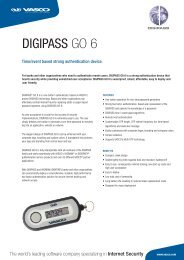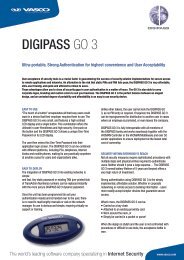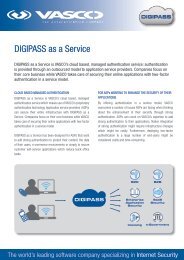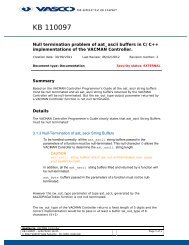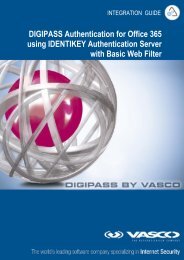Digipass Plug-In for SBR Administrator Reference - Vasco
Digipass Plug-In for SBR Administrator Reference - Vasco
Digipass Plug-In for SBR Administrator Reference - Vasco
Create successful ePaper yourself
Turn your PDF publications into a flip-book with our unique Google optimized e-Paper software.
<strong>Digipass</strong> <strong>Plug</strong>-<strong>In</strong> <strong>for</strong> <strong>SBR</strong> <strong>Administrator</strong> <strong>Reference</strong> Field Listings<br />
Field Name in<br />
Administration<br />
<strong>In</strong>terfaces<br />
Description<br />
Self-Assignment<br />
Password Autolearn<br />
Requesting a Challenge or Virtual <strong>Digipass</strong> OTP, when the<br />
Request Method includes a Password<br />
Static password authentication, when verifying a Virtual<br />
<strong>Digipass</strong> password-OTP combination or during the Grace Period<br />
Always The <strong>SBR</strong> <strong>Plug</strong>-<strong>In</strong> will utilize Back-End Authentication <strong>for</strong> every<br />
authentication request.<br />
Back-End Protocol Specifies the protocol to be used <strong>for</strong> Back-End Authentication.<br />
Options:<br />
Windows Authentication using the Windows operating system.<br />
RADIUS Authentication using a RADIUS server.<br />
This option is not available in <strong>Digipass</strong> <strong>Plug</strong>-<strong>In</strong> <strong>for</strong> <strong>SBR</strong>.<br />
Created On The date and time that the Policy was created. Read-only.<br />
Last Modified On The date and time that the Policy was last modified. Read-only.<br />
Dynamic User<br />
Registration<br />
Specifies whether the Dynamic User Registration (DUR) feature is enabled <strong>for</strong> the Policy.<br />
If this feature is used, when the <strong>SBR</strong> <strong>Plug</strong>-<strong>In</strong> receives an authentication request <strong>for</strong> a User<br />
<strong>for</strong> the first time and Back-End Authentication is successful, it will create a <strong>Digipass</strong> User<br />
account automatically. If DUR is used in conjunction with Auto-Assignment, a <strong>Digipass</strong> will<br />
be assigned to the new User account immediately.<br />
Password Autolearn Specifies whether the Password Autolearn feature is enabled <strong>for</strong> the Policy. This feature<br />
enables the <strong>SBR</strong> <strong>Plug</strong>-<strong>In</strong> to update the password stored in the <strong>Digipass</strong> User account when<br />
Back-End Authentication is successful.<br />
<strong>In</strong> <strong>Digipass</strong> <strong>Plug</strong>-<strong>In</strong> <strong>for</strong> <strong>SBR</strong> it is normally not necessary to store the password in the<br />
<strong>Digipass</strong> User account, so this feature is not typically used.<br />
Stored Password Proxy Specifies whether the Stored Password Proxy feature is enabled <strong>for</strong> the Policy. This<br />
feature can be used in conjunction with the Back-End Authentication Always setting and<br />
the Password Autolearn feature, so that even though a Back-End Authentication check is<br />
done every login, it is done using the password stored in the <strong>Digipass</strong> User account, so the<br />
User does not have to enter it during their login unless it has just changed.<br />
<strong>In</strong> <strong>Digipass</strong> <strong>Plug</strong>-<strong>In</strong> <strong>for</strong> <strong>SBR</strong> it is normally not necessary to per<strong>for</strong>m a Back-End<br />
Authentication check at each login, so this feature is not typically used.<br />
Default Domain The default Domain in which the <strong>SBR</strong> <strong>Plug</strong>-<strong>In</strong> should look <strong>for</strong> and create <strong>Digipass</strong> User<br />
accounts, if a Domain is not specified by the login credentials.<br />
Active Directory only:<br />
If the User logs in with the User-Principal-Name <strong>for</strong>mat (eg. testuser@vasco.com) or the<br />
NT4 style <strong>for</strong>mat (eg. VASCO\testuser), the Default Domain is not used. However, if they<br />
log in with just a UserId (eg. testuser), the Default Domain will be used if specified.<br />
<strong>In</strong> the case that no Domain is implied by the login credentials and there is no Default<br />
Domain, the <strong>SBR</strong> <strong>Plug</strong>-<strong>In</strong> will search in its Configuration Domain.<br />
This must be the fully qualified domain name.<br />
ODBC Database only:<br />
Windows User Name Resolution can be used, in which case the User-Principal-Name and<br />
NT4 style <strong>for</strong>mats will determine the Domain. If the Domain is not determined by that<br />
method, a simple UPN-like <strong>for</strong>mat (ie. testuser@vasco.com) will identify the Domain, when<br />
the Domain exists in the database.<br />
<strong>In</strong> either case, if no Domain has been identified, the Policy's Default Domain will be used if<br />
it is defined. Finally, if there is no Default Domain, the Master Domain will be used.<br />
User Lock Threshold This indicates the number of consecutive failed login attempts that will cause a <strong>Digipass</strong><br />
User account to become Locked. For example, if the User Lock Threshold is 3, the account<br />
will become Locked on the third failed login attempt. Unlocking the account requires<br />
administrator action.<br />
Note that not all kinds of login failure will result in locking. For example, if the UserId is<br />
© 2006 VASCO Data Security <strong>In</strong>c. 88




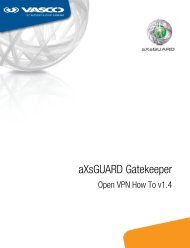
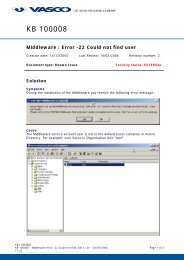
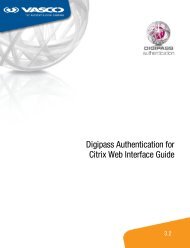
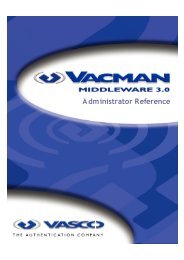
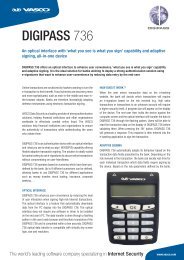
![KB [100006] - Vasco](https://img.yumpu.com/12539350/1/184x260/kb-100006-vasco.jpg?quality=85)

